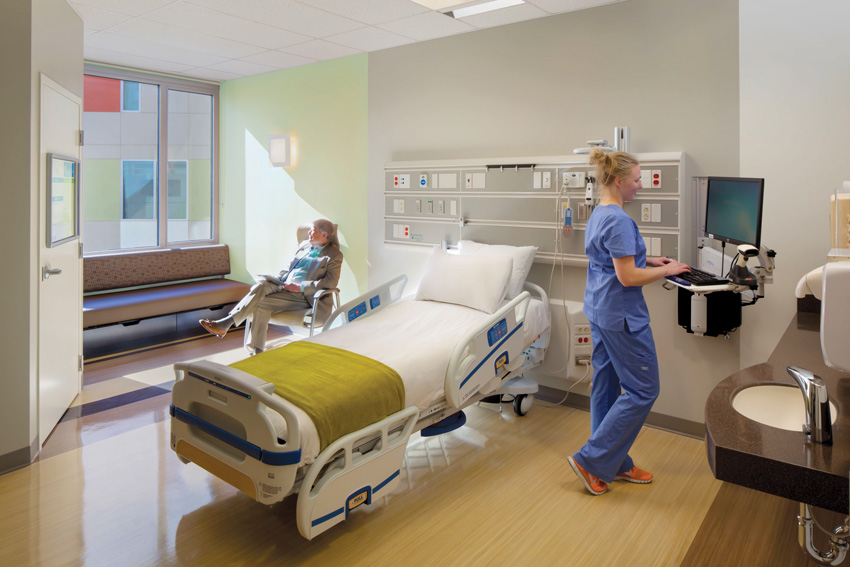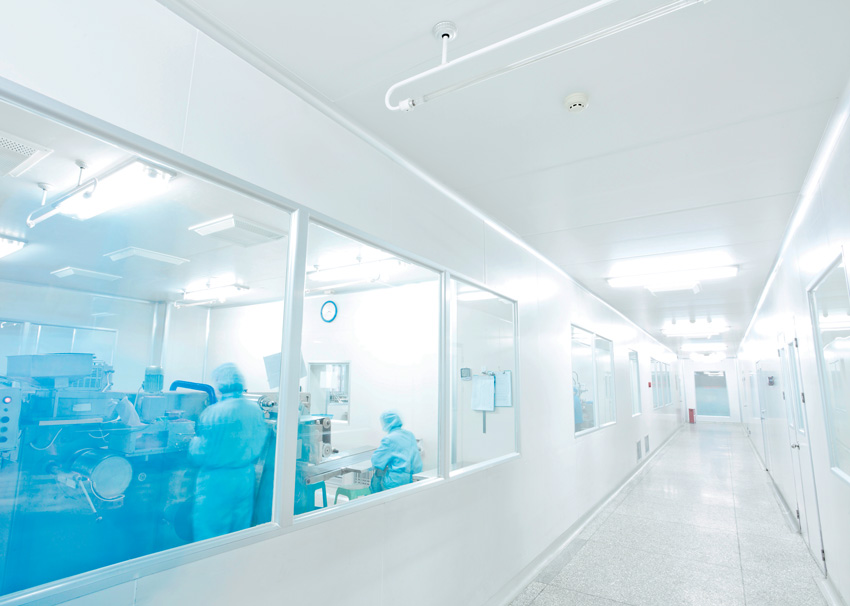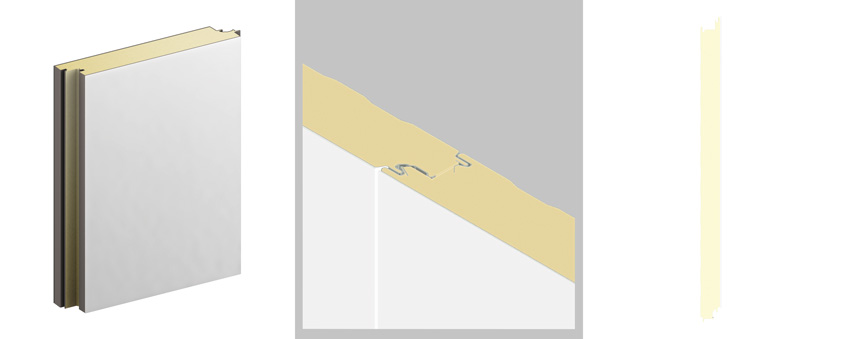Design Strategies for Optimal Well-Being in Health Care Environments
Keeping Bacteria at Bay
According to The Center for Health Design, “…easily transmittable diseases are a serious concern in most facilities today. Implementing some of the latest best practices in your physical environment can help to minimize their impact—and help you get the best outcomes from your efforts.”6 Some of the latest advancements include the advent of a microbicidal paint with the power to kill bacteria on a painted surface, as well as fiber-reinforced plastic (FRP) insulated metal panels that can create airtight seals.

Photo courtesy of The Sherwin-Williams Company
Innovations in paints and coatings, including advancements in microbicidal technologies, can help support critical initiatives in medical settings.
Paints and Coatings
While it’s long been acknowledged that color choice can create a more restful environment, technological advancements in paint and coatings now let architects and specifiers deliver much more to a health-care environment than a soothing color. (More on color later in this course.) Innovations in certain coating technologies support critical initiatives in medical settings, including acute-care and long-term care facilities.
Improving indoor air quality (IAQ) and providing other unique benefits are among the key reasons to consider choosing an advanced coating to optimize the health-care facility setting. Some of the considerations include:
- Formaldehyde-reducing and odor-eliminating technologies help to improve the indoor environment of patient rooms in acute and long-term care facilities.
Hospitals and other facilities face many challenges when it comes to controlling odors, which can emanate from sources such as cafeterias, restrooms, and patient rooms. Odors can be detrimental for hospital patients, visitors, and staff members alike. Paint exists today with odor-eliminating technology that can deconstruct carbon molecules to neutralize and dissipate odors of an organic origin.
Airborne concentrations of formaldehydes and other aldehydes, known as volatile organic compounds (VOCs) that originate from sources such as carpet and insulation, contribute to poor indoor air quality. Paint with formaldehyde-reducing technology actually helps to improve indoor air quality by transforming aldehydes into water molecules and a harmless inert gas, resulting in a reduction in airborne concentrations of formaldehydes and other aldehydes. The length of time these technologies actively reduce odors and formaldehyde depends on the concentration, the frequency of exposure, and the amount of painted surface area.
- Antimicrobial technology can inhibit the growth of mold or mildew on the paint film in patient bathrooms, food service areas, exam rooms, and other areas where moisture is present.
Additionally, there are other benefits related to advancements in paint and coating technologies, particularly those with high-performance and microbicidal properties. Those benefits include the following:
- Microbicidal paint can offer health-care facilities an important new tool to help combat certain bacteria on painted surfaces. For example, one EPA-registered microbicidal paint can kill greater than 99.9 percent of certain bacteria* within 2 hours of exposure on a painted surface.
- High-performance coatings can be chemical and abrasion resistant.
According to Steve Revnew, senior vice president of product innovation at Sherwin-Williams, “For those involved in the decision-making process of selecting a coating for a health-care setting, it’s essential to be aware of new developments in coatings technology and their benefits in order to drive the most impactful outcomes in look and function.”
Paints and coatings go well beyond aesthetics. Advancements in technology mean paint now can accomplish a variety of important tasks ranging from killing harmful pathogens on painted surfaces, to helping reduce odors, to improving indoor air quality.
Revnew adds, “The advent of a microbicidal paint represents a major breakthrough in the industry, with far-reaching benefits for health-care facilities and beyond. This new paint has an active ingredient—quaternary ammonium compound (Alkyl Dimethyl Benzyl Ammonium Chloride)—commonly known in the health-care industry as ‘quat’ that actually kills five disease-causing bacteria. This advancement in technology means hospitals and other health-care facilities now have the ability to continuously kill harmful pathogens on painted surfaces with minimal effort.”
Fiber-Reinforced Plastic Insulated Metal Panels
Another industry solution being used to optimize hygiene and infection control in health-care settings requiring sterile environments are permanent fiber-reinforced plastic (FRP) insulated metal panels. FRP is a composite material made of a polymer matrix reinforced with fibers. The polymer is usually an epoxy, vinylester, or polyesterthermosetting plastic. FRP is commonly used in industries such as aerospace, automotive, marine, and construction.

Permanent fiber-reinforced plastic (FRP) insulated metal panels can provide an infection-control solution in sterile environments by preventing mold and mildew growth.
The panels are designed to create a virtually seamless joint between wall and ceiling to prevent mold and mildew growth. Generally speaking, the joint is where mildew or mold will grow the majority of the time, just like in your bathroom shower at home. While you can get mildew or mold on the walls, mildew or mold growth is more often found growing in the caulking at the joints. For health-care facilities where they may use chemical or high-pressure washes on the wall, the traditional surface-applied silicone or urethane sealants can weaken over time, thereby creating a place for mildew and mold to hide. The two-part welded seal used with permanent FRP insulated metal panels, on the other hand, creates a permanent bond, which does not break down over time with the use of harsh chemicals, frequent hot water, and high-pressure spray cleanings often required to effectively sanitize an area. A specialized caulk system bonds adjacent FRP surfaces together to form a smooth, reliable, long-lasting seal. This virtually maintenance-free system can be a perfect solution for commissaries, processing rooms, clean rooms, or pharmaceutical manufacturing facilities where frequent scrubdowns may be required.
According to Jay Smith, vice president of sales for Metl-Span, a manufacturer of metal roof, wall, and ceiling panel solutions, “The FRP wall and ceiling systems provide an easy-to-maintain and sanitize work station for health-care professionals, allowing them more time to focus on the things that matter.” He adds, “With a greater emphasis on building codes, fire rating standards, aesthetic conditions, and overall building expectations, architects and contractors are being asked to think more critically about wall systems and the specifications. Insulated metal panels, including FRP systems, provide a simple, all-in-one solution as well as an array of finishes and textures, which ultimately deliver functionality and appearance needed for today’s health-care buildings.”
FRP is manufactured and tested to be ideal for clean environments, such as those, as noted, which require a clean down, such as surgical rooms. Other applications include commercial kitchens, public restrooms, hospitals, schools, correctional facilities, restaurants, car washes, meat and dairy facilities, coolers and freezers, supermarkets, clean rooms, and laboratories.
Unlike traditional silicone, which requires maintenance every few years to remove and reseal the panels, with permanent FRP welded panels, the name says it all. Since it’s a permanent weld, it eliminates maintenance downtime. Featuring a lock-and-groove system, the double tongue-and-groove joint is exclusive to an insulated metal panel. This type of joint system provides the air and moisture barrier needed for the wall to protect the interior environment. The FRP panel’s joints are welded together, creating the signature smooth, permanent seal between panels and an area less likely to harbor bacteria, mold, or mildew.

Images courtesy of Metl-Span
Pictured are a profile image of an FRP insulated metal panel (left); a joint view of an FRP insulated metal panel featuring a lock-and-groove system (middle); and a top view of an FRP insulated metal panel (right).
Notice

www.specADsystems.com

metlspan.com

www.swpaintshield.com









